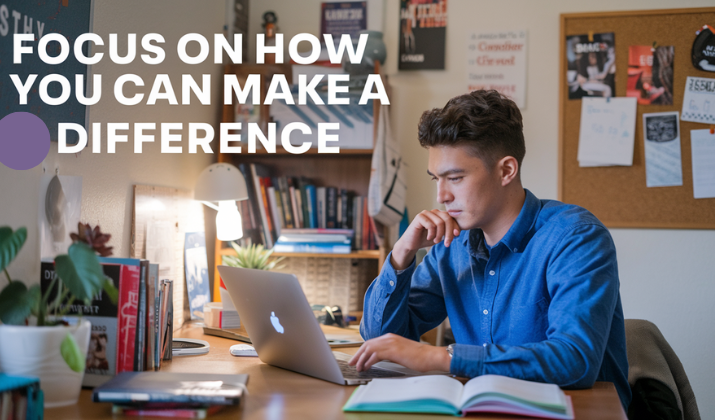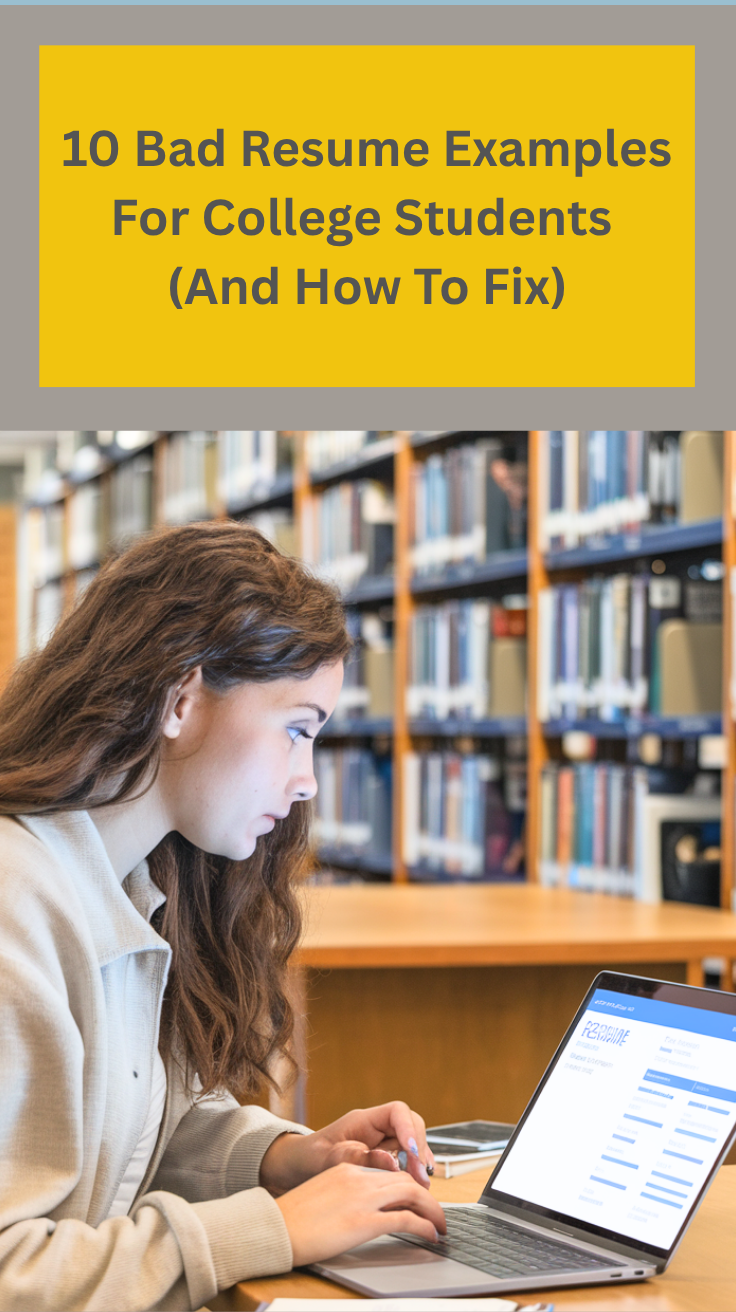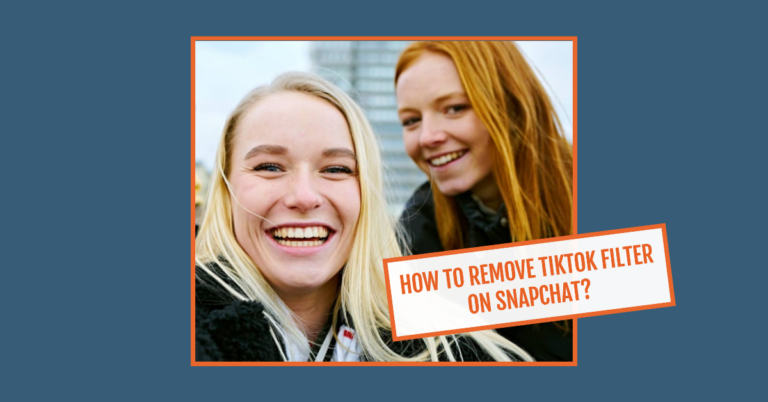Writing a resume as a college student can be intimidating.
You might not have decades of experience to flaunt, and you might not be sure what exactly employers want to see.
Yet, making careless mistakes can prevent even the most qualified student from landing interviews.
Common errors like cluttered layouts, vague descriptions, or generic statements are surprisingly easy to make but equally easy to fix.
In this guide, we’ll go through some examples of bad resumes that college students often create. I’ll also show you how to turn each into a professional, attention-grabbing resume.
Let’s begin.
Bad Resume Examples For College Students And How To Fix
1. The “Everything but the Kitchen Sink” Resume
Many students feel the need to include every activity, class, and part-time job they’ve ever done, from volunteering at a local shelter to taking an elective course in Medieval History.
The result?
A 2–3 page resume that looks more like a biography than a professional snapshot.
Why it’s bad: Recruiters often spend only 6–10 seconds scanning a resume. A cluttered resume buries your strengths, making it hard to see your true qualifications.
Example:
-
Bad: Lists every club, every minor assignment, and jobs with generic titles like “Student Worker – Various Tasks.”
-
Good: Focus on a few meaningful experiences, such as “Organized and led a 50-student campus sustainability initiative, increasing recycling participation by 40%.”
How to fix it: Pick 3–5 experiences that best showcase leadership, skills, or achievements. Keep your descriptions concise, use action verbs, and quantify results wherever possible. Remove experiences that don’t add value to the role you’re targeting. Remember, a focused resume communicates professionalism and clarity.
2. The “Generic Template” Resume
A lot of college students download a free resume template online, fill in the blanks, and call it a day.
While templates are useful for structure, copying them blindly makes your resume look like everyone else’s.
Why it’s bad: Generic resumes fail to showcase your individuality. Recruiters want to see your unique experiences, not just a cookie-cutter layout.
Example:
-
Bad: “Objective: Seeking an internship in marketing to gain experience.”
-
Good: “Marketing intern with experience in social media campaigns and event planning, seeking to help XYZ Company increase engagement and brand awareness.”
How to fix it: Tailor your resume for each application. Adjust the objective/summary, emphasize relevant skills, and highlight experiences that match the job description. Even minor adjustments can make your resume feel intentional and personalized.
3. The “Typos and Errors” Resume
Spelling mistakes, inconsistent punctuation, and formatting errors are surprisingly common, even on resumes of otherwise excellent students.
Why it’s bad: A resume full of errors signals carelessness and poor attention to detail, which are red flags for employers.
Example:
-
Bad: “Resposible for organizing campus events, managin budgets and coordinating with the student club.”
-
Good: “Responsible for organizing campus events, managing budgets, and coordinating with student clubs to host 5+ events per semester.”
How to fix it: Proofread multiple times, read it aloud, and ask a friend or mentor to review it. Use tools like Grammarly or Microsoft Editor, but don’t rely solely on them. Ensure fonts, headings, bullet points, and spacing are consistent across sections.
4. The “Vague Job Descriptions” Resume
Many students list work experience without explaining what they actually did or achieved. Simply stating a job title won’t tell recruiters anything about your skills.
Why it’s bad: Vague descriptions don’t provide context, leaving recruiters guessing about your abilities.
Example:
-
Bad: “Worked at Starbucks.”
-
Good: “Managed daily customer transactions for a high-volume café, prepared beverages efficiently, and trained 3 new team members on company standards, improving service speed by 20%.”
How to fix it: Use action verbs, quantify results, and emphasize accomplishments over responsibilities. Focus on transferable skills like communication, leadership, and problem-solving that will impress employers in any field.
5. The “Objective Statement Disaster”
Some students include outdated or vague objectives, thinking they need one to fill space.
Generic statements like “Seeking a challenging internship” waste space and fail to show why you’re qualified.
Why it’s bad: A vague objective doesn’t tell recruiters what makes you special.
Example:
-
Bad: “Seeking a challenging internship to gain experience.”
-
Good: “Aspiring data analyst with coursework in statistics and Python, seeking to leverage analytical skills to help XYZ Company interpret and utilize data effectively.”
How to fix it: Either replace the objective with a summary that highlights your key skills or make your objective very specific to the role. Focus on what you can bring to the company, not what you want from them.
6. The “Unprofessional Email or Social Handles” Resume
Using an email like hotshot99@gmail.com or including personal social media accounts can instantly hurt your credibility.
Why it’s bad: Employers expect professional communication, and unprofessional contact information reflects poorly on you.
Example:
-
Bad: Email: partygirl2003 @ gmail.com | Instagram: @ funnyme123
-
Good: Email: steve.woznaik @ email.com | LinkedIn: linkedin. com/steve-woznaik
How to fix it: Use a simple email with your first and last name. Only include professional social media or portfolio links, such as LinkedIn or a personal website showcasing projects.
7. The “Chronological Confusion” Resume
Some students mix up dates or list experiences in a random order, making it hard for recruiters to follow their career progression.
Why it’s bad: Recruiters skim quickly. If your timeline is confusing, your experience won’t make sense, and you risk being passed over.
Example:
-
Bad: “Internship at XYZ Company – 2022, Part-time Job at Café – 2023, Volunteer – 2021.”
-
Good: “Part-time Barista, Café Aroma, Jan 2023 – Present | Marketing Intern, XYZ Company, Jun 2022 – Aug 2022 | Volunteer, Local Shelter, Sep 2021 – Dec 2021”
How to fix it: List experiences in reverse chronological order. Include months and years, and maintain consistent formatting for titles, organizations, and dates. This makes your resume logical and easy to navigate.
8. The “Buzzword Overload” Resume
Stuffing resumes with buzzwords like “hardworking,” “innovative,” or “team player” without examples doesn’t convince recruiters of anything.
Why it’s bad: Words without proof are meaningless. Recruiters want evidence of your abilities.
Example:
-
Bad: “Hardworking team player seeking internship.”
-
Good: “Collaborated with a team of 5 students to plan a campus charity event, coordinating logistics and marketing that resulted in a 30% increase in attendance compared to previous year.”
How to fix it: Pair descriptive words with measurable achievements. Show impact through real experiences rather than generic adjectives.
9. The “Skills Section that Reads Like a Grocery List”
Listing every software or skill you know, no matter how minor or irrelevant, makes your skills section cluttered and ineffective.
Why it’s bad: Recruiters need context for how your skills apply to a job. A disconnected list is unhelpful.
Example:
-
Bad: “Skills: Excel, Photoshop, PowerPoint, Python, Canva, Microsoft Word, TikTok, Social Media, Video Editing”
-
Good: “Skills: Excel (data analysis and budgeting), Photoshop (social media graphics), Python (basic data processing), Social Media Management (Instagram & LinkedIn campaigns).”
How to fix it: Focus on 5–7 key skills relevant to the job, and demonstrate their application in your experience section. This shows recruiters how your skills translate into results.
10. The “Ignoring White Space and Layout” Resume
Cramped text, tiny fonts, and inconsistent formatting may seem like a way to fit everything in, but it backfires.
Why it’s bad: Poor formatting makes your resume hard to read and appear unprofessional, regardless of your achievements.
Example:
-
Bad: Single-spaced text with multiple font sizes, dense paragraphs, and no headings.
-
Good: Clean one-page layout, clear headings, 10–12 pt font, proper spacing, and consistent bullet points for each section.
How to fix it: Use white space to guide the reader’s eye. Stick to one font, maintain consistent formatting, and prioritize readability. A well-structured, visually appealing resume makes your achievements stand out.
Conclusion
Your resume is your first impression, and even small mistakes can prevent you from landing interviews.
Avoid clutter, vague descriptions, unprofessional contact info, and generic statements. Focus on relevant experiences, measurable accomplishments, and professional presentation.
With a tailored, clean, and thoughtfully organized resume, you can effectively communicate your potential to recruiters and dramatically increase your chances of landing the opportunities you want.
Remember, a resume isn’t just a list, it’s the story of your skills, experiences, and potential. Make it compelling, credible, and uniquely yours.

















